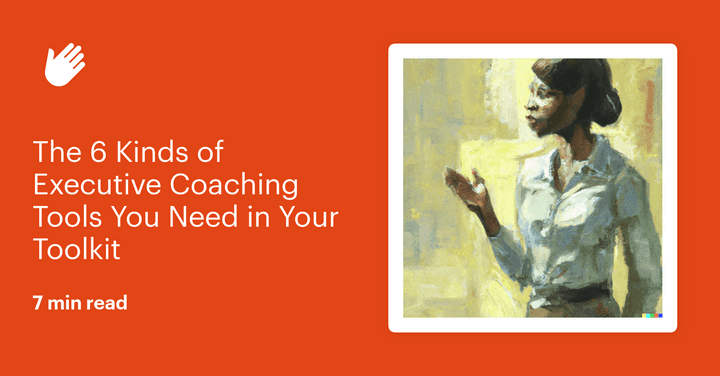The 6 Kinds of Executive Coaching Tools You Need in Your Toolkit

Executive coaching isn’t about fancy tools.
No tool can replace your experience, strategies, or dedication—but that doesn’t mean they can’t help you succeed as an executive coach. Whether it’s time management, client assessment, or just smoother communication, these tools help modern executive coaches build their businesses and offer more to their clients.
That’s why we’ve compiled this list of different executive coaching tools available to you. You may decide you don’t want or need some of these tools, and that’s okay. But you may just find there’s a tool out there for you that can help you offer your clients so much more in your time together.
1. Productivity tools
If your business is doing well, you may be mentoring several clients at a time. That's a huge time commitment and requires a lot of planning and management. It also means that the size of your business will be limited by how many clients you can properly help at any given time.
Luckily, there are ways to reduce the amount of time you spend on each client without reducing the quality of your services. With the right productivity tools, you can be more efficient and squeeze every last ounce of value out of your working hours.
Specifically, productivity tools help:
- Keep you on task: Use tools like a Pomodoro timer to block your time efficiently for fewer distractions and more deep work.
- Manage your calendar: Everyone has a digital calendar at this point, but managing it can be a time suck. Try AI calendar assistants Reclaim or Routine for smart calendars that arrange your day for you.
- Save you time: Coaches spend hours reviewing transcripts, emails, and assessment docs to help their clients, but they don’t need to. You can use AI to create original content from your conversations with clients.
Beyond saving you time and effort, productivity tools can also help you stave off burnout. Doing too much for too long can have devastating impacts on your mental, physical, and emotional well-being.
For instance, Heyday is an AI memory assistant designed to help people avoid information overload. Executive coaches spend considerable time reading through countless documents, transcripts, and articles to better serve their clients. All of this mental strain adds up, making you less present in conversations and ultimately less effective as a coach.
Heyday fixes this by doing the busy work for you. Forgot about the key areas that your client is working to make progress in? Heyday sends you an email before calls with recurring themes from past conversations and key takeaways from recent ones to help you keep clients moving forward.
Interested in seeing how Heyday can help you be a better executive coach? Check out our homepage to start a free 14-day trial today.
2. Assessment tools
Early in the coaching relationship, you’ll need to assess your mentee's current strengths, weaknesses, and priorities. Assessment tools make it easier for you to quickly and efficiently discover what you need to put your client on the path to success.
The right assessment tools help you:
- Identify strengths and weaknesses: Tools like CliftonStrengths, the Myers-Briggs Type Indicator, and the DISC assessment provide valuable insights into your clients' personalities, skills, and work styles.
- Measure progress: Using assessments at various stages of the coaching process can help track your clients' development and make data-driven decisions about their growth.
- Enhance self-awareness: Exercises like the Wheel of Life, journaling prompts, or values clarification exercises can help your clients gain a deeper understanding of their priorities, values, and areas for growth.
Not all assessment tools need to be digital or complicated, either. Having a collection of assessment tools at your disposal helps analyze your new clients regardless of the goals or fields they need help in.
3. Goal-setting and action planning tools
Once you and your client have aligned on the desired outcomes of your coaching relationship, it’s time to set goals that’ll get them there. Integrating goal-setting and action planning tools into your coaching practice can provide structure and clarity for your clients, ensuring they stay motivated and on track to reach their objectives.
Goal-setting tools help your clients set SMART (Specific, Measurable, Achievable, Relevant, and Time-bound) goals and create actionable plans to achieve them, ensuring their progress is tangible and sustainable.
These kinds of tools help:
- Structure client goals: Platforms like Goalscape or Toggl Plan can help your clients break down their goals into smaller, manageable steps, making tracking progress and staying focused easier.
- Prioritize tasks: Tools like Todoist or Any.do help clients prioritize tasks and manage their daily workload effectively.
- Encourage collaboration: Platforms like ClickUp or Monday.com allow your clients to collaborate with their teams in achieving shared goals and milestones, fostering teamwork and collective growth.
By helping your clients create well-defined goals and detailed action plans, you can support them in realizing their full potential and achieving the success they aspire to.
4. Communication tools
Effective communication is at the heart of successful coaching relationships. However, chances are you don’t live in the same city, let alone the same state or country. With the right tools, you can streamline communication, schedule meetings, and collaborate with your clients efficiently, no matter where they are.
Use communication tools to help with:
- Seamless communication: Tools like Slack or Google Hangouts help you stay in touch with clients and provide timely support wherever you are.
- Easy scheduling: Apps like Calendly or Doodle simplify the process of scheduling coaching sessions and minimize the back-and-forth of finding suitable times.
- Better analysis: Tools like Otter or Rev allow you to transcribe your client meetings so you can review client conversations more easily.
With these tools, you won’t miss another word of what your clients have to say. Implementing the right communication tools into your coaching practice enhances your ability to connect with clients across the globe.
5. Coaching exercises and tools
Coaching exercises and tools play an essential role in stimulating self-reflection, generating insights, and facilitating transformative conversations with your clients. These resources help your clients explore their thoughts, beliefs, and behaviors and create lasting change in their personal and professional lives.
Coaching exercises and tools help your client:
- Improve decision-making: Resources like the GROW model, the SWOT analysis, or the Eisenhower Matrix can assist your clients in making more informed choices and taking purposeful action.
- Boost emotional intelligence: Emotional intelligence exercises, such as the Wheel of Emotions or empathy-building activities, can help your clients develop self-awareness, self-regulation, and relationship management skills.
- Foster creative problem-solving: Techniques like mind mapping, brainstorming, or the Six Thinking Hats help your clients generate new ideas, explore alternative perspectives, and overcome challenges more effectively.
Incorporating a variety of coaching exercises and tools into your practice can help you create a more engaging and impactful coaching experience for your clients. By carefully selecting exercises that resonate with your client's needs and goals, you empower them to take charge of their growth and drive lasting change.
6. Continuous learning resources
As an executive coach, staying up-to-date with the latest coaching methods, industry trends, and best practices is essential. Continuous learning resources can help you hone your skills and provide better coaching services to your clients.
Continuous learning resources can help you:
- Access expert knowledge: Platforms like Coursera or MasterClass offer courses from industry experts to help you expand your coaching toolkit.
- Stay informed: Subscribing to newsletters, podcasts, or blogs keeps you updated on developments and emerging trends in your client’s fields.
- Join a community: Professional organizations, such as the International Coach Federation, offer networking opportunities, conferences, and resources to support your coaching practice.
Using continuous learning resources keeps you updated as an executive coach, ensuring you deliver relevant, impactful guidance in an ever-evolving landscape.
You are your ultimate executive coaching tool
As an executive coach, your ability to guide and support your clients is directly linked to your own personal growth and mental well-being. Investing in yourself through continuous learning, self-care, and personal development is crucial for maintaining your effectiveness as a coach.
Give your clients 100% during every interaction
One key aspect of being an outstanding coach is ensuring your mental energy remains high. Not only does this keep you happier and healthier, but it also allows you to consistently deliver value.
